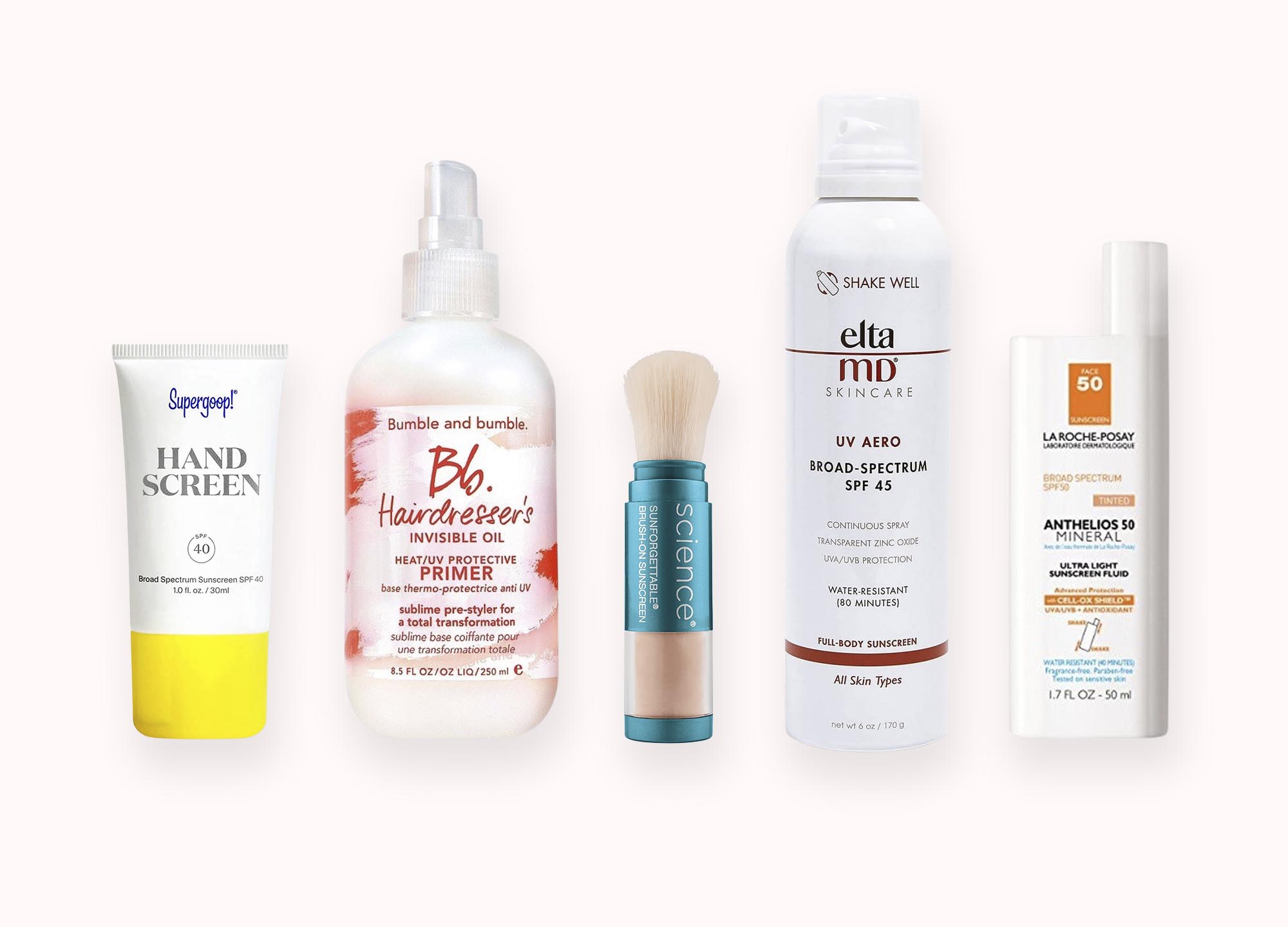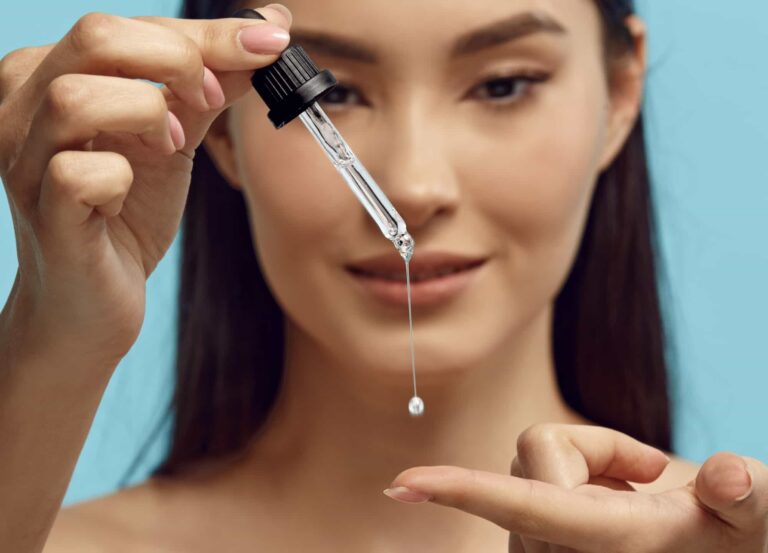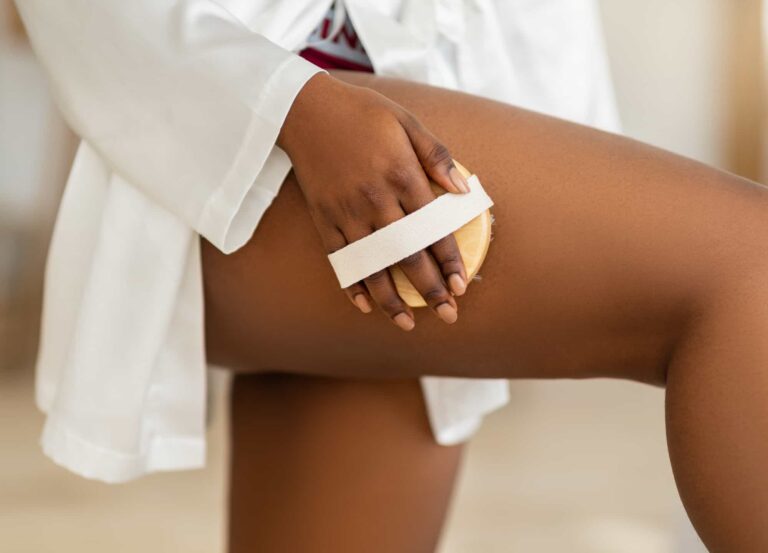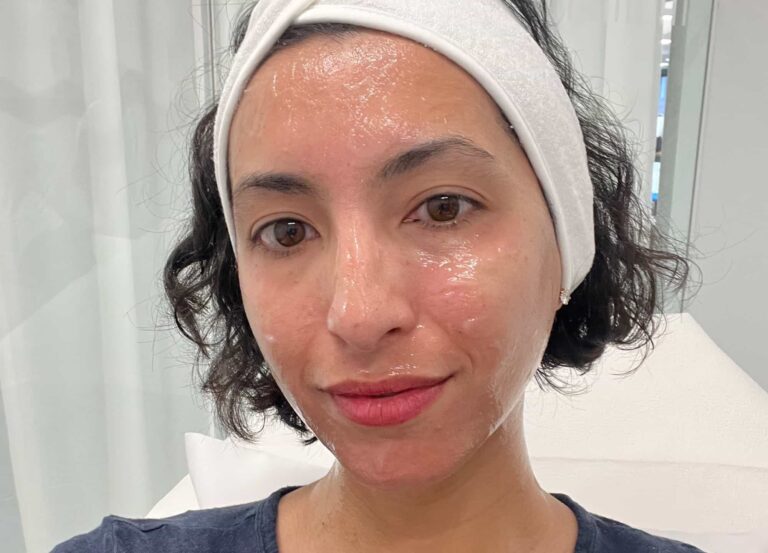As we continue to be inundated with Instagram memes about the importance of wearing sunscreen and countless campaigns warning of skin cancer’s horrors, it’s hard to believe that there was ever a time when it was normal to lie in the sun, not a care in the world, lathering yourself in tanning oil. In many ways, we’re more thoughtful about sun protection now than ever before. But even if it feels like you can’t throw a rock without hitting “wear sunscreen” advice—from your doctor, your partner, your mother, your favorite magazine, this article—data shows that sunscreen use among Americans is still slow. According to a 2020 RealSelf Sun Safety Report, only 11% of Americans wear sunscreen daily.
These stats help explain why more people in the United States are still diagnosed with skin cancer each year than all other cancers combined. Dermatologists and skin experts believe that one major contribution to these staggering numbers is the all-too-common neglect of certain areas of the body, including those that are most susceptible to sun damage. RealSelf data shows that among those who do wear sunscreen at least one day a week, most apply protection to their face, neck and arms. When it comes to protecting exposed skin from the sun’s powerful rays, it’s easy to remember your nose or shoulders; but many people, even the savviest of sunscreen users, often forget about some of the other most vulnerable spots.
Eyelids
Chief among these regions is the eyelids, where a shocking 5–10% of all skin cancers occur. “The eyelid is the thinnest skin on the entire body, so it’s a very unforgiving part of our face,” explains Palo Alto, California, board-certified oculoplastic surgeon Dr. Andrea Kossler. According to another study published earlier this year, it’s also where we’re mostly to skimp on sunscreen. “A lot of people don’t put sunscreen all the way up to their eyelid margins because, of course, they don’t want to get it in their eyes and have them burn or sting—and I don’t think that people ever really suspect they can get skin cancer on their eyelids,” says Dr. Kossler. “But when these preventable things happen, they can have significant consequences to the function of the eye, the appearance of the eye … and in the worst case scenarios, patients still, to this day, are losing their eyes.”
Related: Hyperpigmentation: How 5 Skin Experts Treat Their Own Sun-Related Skin Damage
The surgeon notes that this delicate skin is also typically the first to show signs of aging, such as wrinkles and dark circles. “Often times, we think cancer won’t happen to us, but we know that aging is going to happen to all of us,” she says. “Of course, we want people to use sunscreen, especially around the eyelids, because of skin cancer, but UVA radiation is also what causes photoaging and wrinkling, so that’s another thing we really want to protect against.” Dr. Kossler, however, fully acknowledges how difficult it can be to find a sunscreen that the sensitive eyelid area can tolerate. “Most types of chemical sunscreen are very thick and sticky—some of them smell bad, and some can leave a white residue on your face,” she says. That’s why she recommends using a mineral sunscreen, like La Roche-Posay Anthelios Mineral Tinted Sunscreen for Face SPF 50 ($35), since they’re much gentler and tend to be less likely to cause any kind of skin irritation than their chemical counterparts. “I really like the tinted forms of sunscreen because you can see where you’ve applied it to some degree, so you won’t miss a spot,” she explains. (To that point, yes, it is both encouraged and ok to apply sunscreen under eyes.)
In order to prevent sunscreen from getting in your eyes, you can also opt for one of the eye-specific sunscreens out there. Supergoop Shimmershade ($24) is a budge proof cream eyeshadow that touts a built-in SPF 30, making it easy to protect your top lids. And the SkinCeuticals Physical Eye UV Defense SPF 50 ($31) is a 100% mineral option that’s both ophthalmologist- and dermatologist-tested, specially formulated for use around the entire area, and that doesn’t run or migrate, minimizing the risk of it ending up in your eyes. Still, at the end of the day, “It really doesn’t matter too much what sunscreen you use though,” Dr. Kossler says, “as long as you like it and you’re compliant in using it.”
“Protecting the face requires protecting the whole face,” agrees Dr. Heidi Waldorf, a board-certified dermatologist in Nanuet, New York. In addition to sunscreen, mechanical protection, such as wearing sunglasses and/or a hat, is especially key. “The sun is not only bad for the skin around your eyes, it’s also bad for the eyes themselves,” says Dr. Kossler. “It can accelerate cataracts, it can affect the retina and it can cause growths on the conjunctiva—so sunglasses are great for protecting the eyelid skin, but they’re also great for protecting the eye.” Dr. Waldorf warns patients that although they may think a visor of baseball hat is protection enough, “Full-face protection requires a hat with a three- to four-inch brim, an extra-wide visor [like this one from Coolibar] or the newest thing in sun protection, a Blue Stone Sun Shields face shield.”
Scalp and hair
Another commonly neglected part of the body is, perhaps unsurprisingly, the scalp. “The scalp burns more easily than anywhere else because it’s at the highest point on your body,” says New York City board-certified dermatologist Dr. Debra Jaliman. But even as we’re warned of the painful and dangerous consequences that can come with not protecting our scalp from the sun, many people are reluctant to spray or lather oily sunscreen on their hair. For anyone who’s bald, “taking precautions when out in the sun is extremely important,” says Dr. Jaliman. She encourages using the same sunscreen you would use on the rest of your body but advises reapplying very frequently. For those who are more follically blessed, she suggests wearing your hair in a bun, top knot or ponytail, which will keep your scalp from being exposed and sunburned. But even so, your scalp and hair are still at risk for UV damage.
You can put sunscreen on the scalp, but if you don’t want the oily residue from a lotion or a spray, consider a powder formula, says Dr. Jaliman. “You can apply it directly on the scalp, without having any product build-up in your hair.” Both she and Dr. Kossler are big fans of the Colorescience Sunforgettable Total Protection Brush-On-Shield SPF 50 ($66). The Isdin Isdinceutics Mineral Brush ($55) is another choice option, as is the Derma E Sun Protection Mineral Face Powder SPF 30 ($22). (As an added bonus, these powder formulas also make it easy to reapply sunscreen on your face throughout the day, especially when you’re wearing makeup.) “There are also mousse formulas you can apply to the scalp, which will lessen the greasiness or oiliness that more traditional sunscreens will leave behind,” says Dr. Jaliman. She recommends the Supergoop Play Body Mousse SPF 50 ($34).
Related: Melasma: The Hyperpigmentation That’s Hardest To Treat
Also at risk here is your actual hair. Sunlight is very drying, and UV rays can make hair look frayed and brittle, so a host of products are now available to protect both the scalp and the hair on top of it. “Maintaining healthy hair when working against the effects of aging, chemical treatments, and the sun’s harmful rays is crucial,” says Scottsdale, Arizona, colorist Lisa Fresa Palacios. “A product containing UV protectant will help protect your color and the integrity of your hair during prolonged sun exposure.” Many skin and hair experts alike rave about Coola SPF 30 Organic Scalp & Hair Mist ($26) and Bumble and Bumble Invisible Oil Heat & UV Protective Primer ($29), Palacios’s personal favorite.
Ears
“Ears are often missed,” says Dr. Jaliman. “Even when people are applying sunscreen to the rest of their face, they forget the ears.” The area, however, is among the most at risk for skin cancer, and a 2007 study from the Skin Cancer Foundation listed ears as the third most common location for skin cancers. Ears are notoriously difficult to shield from the sun and are therefore frequent targets of sun exposure; their thin skin and minimal subcutaneous tissue also make them even more likely to develop malignancies.
It’s understandably difficult to coat our ears in sunscreen—after all, who wants a bunch of sticky, white liquid seeping into their ear canals? It’s also a challenge to get every part of the ear that’s actually exposed and not just the lobes. Enter the beauty of solid, stick sunscreens, which, according to Dr. Jaliman, are ideal for use on the ears. Notable options include the Shiseido Clear Sunscreen Stick SPF 50+ ($29) and the Sun Bum Sunscreen Face Stick SPF 30 ($10), a favorite of Dr. Kavita Mariwalla a board-certified dermatologist in West Islip, New York. Sticks are another way to ensure reapplication is easier than ever, which Dr. Mariwalla says is paramount, no matter what area of the face or body you’re talking about. “I don’t think it’s always that people are forgetting to apply sunscreen to these areas but rather, they’re not reapplying,” she points out. “I’ll often ask my patients if they wear sunscreen, and they’ll say yes, SPF 50 or SPF 70—but when I ask if they reapply it, they always say no. So I think what people forget is that it doesn’t matter what number you put on. If you’re not reapplying, what does it matter what you used three hours ago?”
Lips
We’re willing to devote time, effort, and money to getting the perfect pout through lip goss and injectable fillers, yet very few of us even consider using UV-protectant products on our lips. Not only are our lips constantly exposed to the sun, the skin there is also extremely thin and contains less melanin. That means that lips are both easy targets for sunburn and at an increased risk of developing precancer actinic keratoses, the scaly bumps and patches that can lead to melanoma. Still, the lips are among the most frequently missed spots when it comes to sunscreen application. And even if you do remember to swipe on some sunscreen, “many people lick their lips, so they end up licking off the sunscreen,” notes Dr. Jaliman.
Rather than put sunscreen on lips, opt for one of the many lip balms out there with SPF protection. Both Dr. Jaliman and Dr. Mariwalla like the EltaMD UV Lip Balm Broad-Spectrum SPF 36 ($13), which is water-resistant for up to 80 minutes and contains vitamin E, vitamin C, castor oil, and olive oil. “Not only do you get sun protection, but it also deeply hydrates your lips,” says Dr. Jaliman.
The eos Natural SPF 30 Lip Balm Stick ($3.50) is another option that’s affordable, mineral-based, and reef-friendly. On top of a good lip sunscreen, Dr. Mariwalla urges her patients to also use a reparative lip product every morning and night. “Over time, as you get a lot of sun on your lips, they lose the collagen and plumpness they once had. This is a great way to combat the damage that happens throughout the day,” she says. She likes SkinCeuticals Antioxidant Lip Repair ($42).
Hands and feet
And now, to round out the most depressing version of “Heads, Shoulders, Knees and Toes,” we come to our final entry, the backs of the hands and the tops of the feet. We eat with our hands, we decorate our hands with jewelry, and some of us even talk with our hands. Still, “a lot of people don’t think to apply sunscreen on their hands, especially if they’re doing basic activities,” notes Dr. Mariwalla. And even when you do initially remember, you still might not be totally covered. “Some people will apply sunscreen all over their body and even on their hands,” says Dr. Jaliman. “But once they’re done, they wash their hands before the product even gets a chance to penetrate into the skin.” It’s part of the reason why the hands can be some of the most telling indicators of age, with wrinkles, crepey skin, and spots showing up here even if they’re not present on the face. Hence why it’s so important to treat hands to a little (or a lot) of SPF. Any sunscreen will get the job done, but, just as mineral formulas tend to be best to use around the eyes, a mineral formula can also be a good idea here, especially if you tend to rub your eyes or touch your face a lot. You can also opt for a separate hand sunscreen.
The Jane Iredale HandDrink Hand Cream SPF 15 ($29) is a mineral formula that has the National Skin Cancer Foundation’s seal of approval for daily use. The Supergoop Handscreen SPF 40 ($14) comes in a convenient travel size and is a favorite of Dr. Jaliman’s, who lauds it for the addition of antioxidants. “It contains both omega-7 fatty acids and antioxidant- rich sea buckthorn fruit, which has been shown to help lighten dark spots,” she says.
Related: Eight Weeks After My Halo Laser Treatment, I Can Say It Was Worth It
“A lot of people forget the tops of their feet,” Dr. Mariwalla says. “Even if they apply sunscreen once, it can easily wear off, simply because of things such as footwear.” As the American College of Foot and Ankle Surgeons warns though, skin cancer of the foot is common, often taking the form of an abnormally shaped mole or freckle—and it can even be fatal. That’s why it’s so crucial to apply sunscreen literally from head to toe. While your little piggies definitely need sun protection, you don’t have to search far and wide for sunscreens made for feet; just use the sunscreen you’d typically apply to the rest of your body. Dr. Mariwalla recommends the Coppertone Sport Sunscreen Lotion SPF 30 ($9), which she says absorbs really well into the skin. Dr. Waldorf is a big fan of EltaMD UV Aero Broad-Spectrum SPF 45 ($36.50), an easy-to-use spray.
Tips and reminders for every part of your body
Although it may feel like we’ve covered every inch of the body in talking about the eyelids, scalp and hair, ears, lips, hands and feet, it’s important not to forget the usual suspects in the midst of your newly acquired sun-protection habits. Every skin expert will stress the importance of reapplying sunscreen to every region, but it’s equally wise to make a habit of putting on sunscreen every morning, even if you’ll just be in the car or walking down the block to the subway station. “Apply sunscreen to the face, neck, décolletage and hands, all at once,” advises Dr. Waldorf.
She also thinks it’s always a good idea to carry sunscreen with you at all times, especially since so many are now available in travel-friendly sizes, and invest in a Sunbrella, if you can. Dr. Mariwalla, despite seeing sunburns and skin cancer in her office every day, is continually stunned by how people think about sun exposure. “I always find it interesting to hear what people consider being ‘out in the sun,’” she says. “There still seems to be this kind of feeling that you need to wear sunscreen only when you’re going to the beach or you’re lying out, but you should be wearing and reapplying sunscreen all the time.”
One more major misconception about sun protection is that just because an area of skin is covered by clothing, it’s not susceptible to sunburn or UV damage. In reality, most clothing provides, at most, the equivalent of SPF 30 (and it’s usually closer to SPF 5)—and of course, not all clothing is created equal. The type of fiber, the tightness of the weave, the weight and the color all factor into the amount of protection provided. Dr. Mariwalla says that, for her patients who will be in the sun for extended periods of time, she suggests using Rit Sun Guard ($30), a laundry additive that transforms clothing into UV-protectant gear. She also notes that, although many people are unaware, SPF rash guards (or swim shirts, as they’re sometimes known) lose effectiveness over time. “The reason it’s sun-protective is the fibers and the tightness of the weave—so just like anything, as the shirt wears thin, it’s going to lose its SPF.” To avoid this dulling down, buy new rash guards every two years or after two seasons of regular use.











